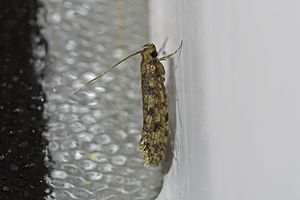Lindera tessellatella facts for kids
Quick facts for kids Lindera tessellatella |
|
|---|---|
 |
|
| Bran moth (Lindera tessellatella) | |
| Scientific classification | |
| Kingdom: | |
| Phylum: | |
| Class: | |
| Order: | |
| Family: | |
| Genus: |
Lindera
Blanchard, 1854
|
| Species: |
L. tessellatella
|
| Binomial name | |
| Lindera tessellatella Blanchard, 1852
|
|
| Synonyms | |
|
|
The Lindera moth is a fascinating insect. It belongs to a group of moths called Tineidae, also known as fungus moths or clothes moths. This particular genus, Lindera, has only one known species: Lindera tessellatella.
A scientist named Blanchard first described the Lindera genus in 1854. He had actually described its only species, Lindera tessellatella, two years earlier, in 1852. This moth is quite special because it can be found all over the world!
Contents
Where Do Lindera Moths Live?
This moth was first discovered in South America. But since then, it has been seen in many other places. You can find Lindera tessellatella in:
- Africa
- Europe
- North America
- Australia
- New Zealand
- Fiji
- Hawaii
This wide distribution shows how adaptable these small moths are. They can survive in many different environments across the globe.
What Does a Lindera Moth Look Like?
The Lindera tessellatella moth is a small to medium-sized moth. Its wingspan (the distance from one wingtip to the other when the wings are spread out) is usually between 20 and 30 millimeters. That's about the length of two to three small paper clips!
Wings and Color
The front wings of this moth are quite shiny. They are a grey-brown color and have a cool speckled pattern that is a bit darker. This pattern helps them blend in with their surroundings.
Head Features
If you look closely at the moth's head, you'll notice something interesting. The tiny scales on its head point forward. They also go down over the front part of its head. This gives the moth a unique look.
What Do Lindera Moths Eat?
The young moths, called larvae, have a very interesting diet. They are like nature's clean-up crew!
- They eat detritus, which is a fancy word for decaying organic matter. Think of it as tiny bits of dead plants and animals.
- They also munch on stored food products. This means they might sometimes be found in places where food is kept.
- Another part of their diet includes the remains of other arthropods. Arthropods are creatures like insects, spiders, and crustaceans.
This varied diet helps them survive in many different places.

